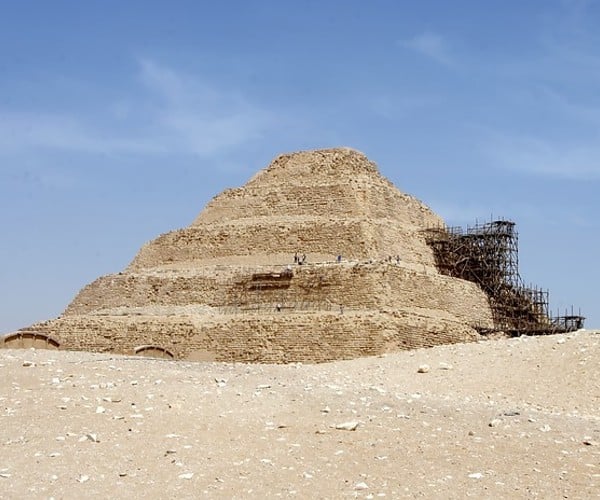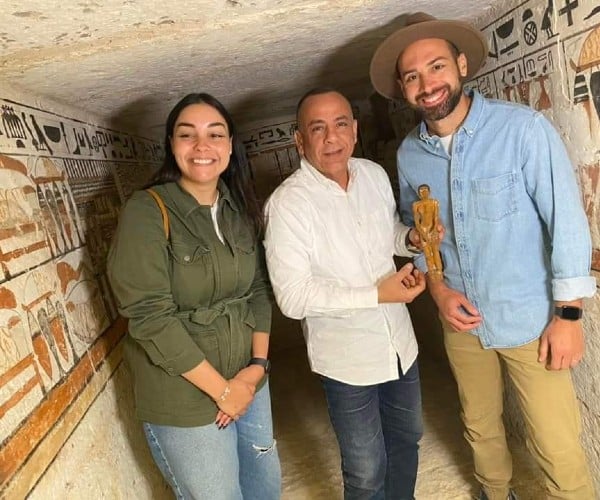Egypt’s newly-discovered ancient tombs in Saqqara
For 5,000 years, Saqqara, the magnificent necropolis and pyramid field of Memphis, Egypt‘s ancient capital, has been an important historical site. The modest square tombs (mastabas) of the rulers of the first and second dynasties can be found in this huge area about 20 miles south of Cairo. Djoser, the first king of the third dynasty, commissioned his vizier and chief architect to construct the first monument in ancient Egypt made entirely of stone. The result is the iconic Saqqara step pyramid and its surrounding funeral complex, which was encircled by a massive wall, most likely modeled after the one that ringed Memphis itself.

At Saqqara, sixteen more Egyptian monarchs constructed pyramids, which are currently in various degrees of preservation. Throughout the Pharaonic period, high officials constructed private funeral monuments to this necropolis. For more than 3,000 years, even into the Ptolemaic and Roman eras, it was a major complex for non-royal burials and cult rites.
Abusir is to the north of Saqqara, and Dahshur is to the south. The area between Giza and Dahshur has been used as a necropolis by Memphis residents at various times, and UNESCO listed it as a World Heritage Site in 1979. According to some experts, the name Saqqara is derived from a local Berber clan called Beni Saqqar, not from the ancient Egyptian funeral deity Sokar.
The Serapeum, where the Egyptians buried the holy bulls of Apis, is one of the most important historical sites in Saqqara. These bulls were thought to be reincarnations of the Egyptian god Ptah, and they are now neatly mummified in massive stone coffins.
It can take hours to view everything in Saqqara because it is such a large historic monument. The Serapeum, Djoser’s burial complex, and the Mastaba of Akhti-Hotep and Ptah-Hotep are the greatest destinations to see if you only have a limited amount of time.
The latest discovery in Saqqara
The discovery of five ancient tombs in Saqqara, Egypt, was reported on Thursday 17th of March, marking the latest in a series of discoveries in the enormous necropolis south of Cairo.
According to Egypt’s antiquities ministry, the stony tombs date from the Old Kingdom (c.2700–2200 BC) and First Intermediate (c.2181–2055 BC) periods.
They were discovered northeast of the Merenre Pyramid, a 52.5-meter-high edifice constructed during the Sixth Dynasty. The tombs, which are etched with colorful shapes, are said to be those of “top officials,” according to the ministry.
The first tomb, according to Egypt’s Supreme Antiquities Council’s Mostafa El-Waziri, belongs to an officer named IRY.
“A deep burial shaft leads to a chamber adorned with funerary scenes representing offering tables, the seven oils, and the palace’s façade.” Inside the tomb, a limestone sarcophagus was also discovered,” he stated in a statement.
“The second tomb, which has a rectangular burial shaft, belongs to a woman who could be the wife of a man named Yaret, while the third tomb belongs to Pepi Nefhany, who was the supervisor of the great house, a priest, and the purifier of the home.” It has a burial shaft that is six meters deep.”
“The fifth is dedicated to Henu, the royal house’s overseer and superintendent. It consists of a rectangle seven-meter-deep burial shaft, “El-Waziri continued.

“More work and research will be done to uncover more secrets of these graves,” he stated.
In recent years, Egypt has done significant digging operations in Saqqara, revealing plenty of discoveries, including the discovery of a 4,400-year-old tomb of royal priest Wahtye in 2018 and hundreds of mummified animals and statues a year later.
Egypt discovered 52 burial tombs in Saqqara last year, with more than 50 wooden coffins inside. The earliest sarcophagi discovered in the ancient burial place date back 3,000 years.
They also uncovered the funeral temple of Queen Nearit, the first pharaoh of Egypt’s Sixth Dynasty, and her husband, King Teti.
Egypt is hopeful that the discovery, as well as the upcoming launch of a new mega museum near the Giza Pyramids later this year, would help to resurrect the country’s ailing tourism economy.
Tourism has been hit hard by the COVID-19 pandemic in recent years, and it could suffer another hit as a result of Russia’s attempted invasion of Ukraine, with inhabitants from both countries accounting for a large portion of visitors to Egypt.
According to the Ukrainian embassy in Egypt, up to 20,000 Ukrainians were stranded in Egypt’s Red Sea resorts when Russia launched its operation against Ukraine on February 24.
Sherif Khalil is Owner of Dunes & Beyond. Dunes & Beyond offers luxury tours, Nile cruises and desert safaris in Egypt.
If you would like to be a guest blogger on A Luxury Travel Blog in order to raise your profile, please contact us.
Did you enjoy this article?
Receive similar content direct to your inbox.


It’s astounding. How much more of Ancient Egypt’s history will be found? The discoveries keep on coming.
Egypt becomes a more and more attractive destination by the day. My advice to any one going to Egypt is to make sure that you have an expert guide.
Ancient Egypt was so very different from our lives today that you benefit from having someone who can put the discoveries into context.
It’s such a fascinating destination with fantastic leisure opportunities too that I’m always recommending it to people.
Reading this makes me think that it’s time that we caught up on things in Egypt. It must be at least a dozen years since we last went there.
Friends did Egypt 3 years ago. They said a week of culture was enough for them and they followed it up with a week of relaxing on the Red Sea. Sounds an ideal balance to me.
Amazing.Egypt is a treasure with infinite
Wisdom and surprises! Thank you.